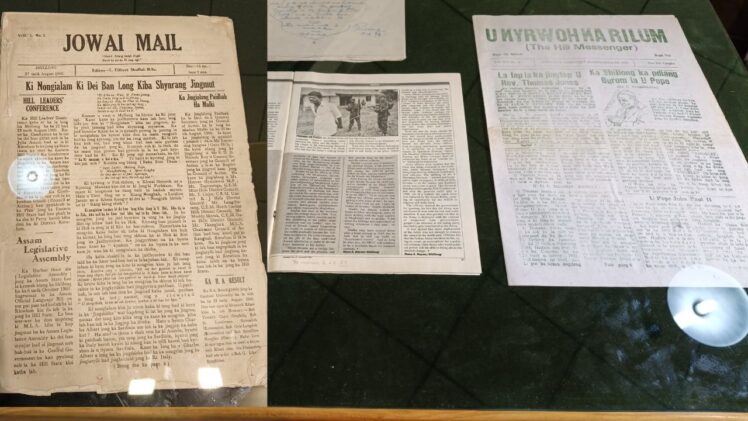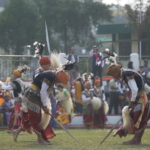
“The more you know about the past, the better prepared you are for the future.” — Theodore Roosevelt
History enriches our understanding of the world and equips us with tools to navigate the future. It helps shape and preserve cultural identity and heritage. It connects individuals and communities to their past, fostering a sense of belonging and continuity.
And for a small tribe like the Khasis with very little documented and catalogued materials about socio-economic, political, and historical culture, tradition, myths, and legends, collecting and preserving archives is all the more important.
Though rich in oral tradition and heritage, the Khasis received the written language only nearly two centuries ago when a Welsh missionary named Thomas Jones aided the Khasis in developing a script using the Latin alphabet.
Understanding the importance of preserving and cataloguing archives, the Shillong Records Collection Centre (SRCC) was formed in 1974 by scholar and former politician (L) L Gilbert Shullai for he understood that preserving archives is crucial for maintaining historical records and ensuring that valuable information remains accessible for future generations. This Centre is a one-man collection and has become a storehouse of knowledge and information.
A LITTLE ABOUT L GILBERT SHULLAI:
(Late) L Gilbert Shullai completed his BA from St. Anthony’s College. In 1954, he entered government service and served as an employee of the Assam Secretariat for 20 years. After leaving the above service in 1972, Shullai entered politics and served as the Chief Executive Member (CEM) of the Khasi Hills Autonomous District Council (KHADC).

While holding the post of CEM, he realised the value of historically important records, information, documents, and materials that have a credible bearing on good governance and building up the future institutional capacities of the society.
After much thought, he relinquished the post of CEM on 14th June 1974. He voluntarily took up the noble but heavy task of collecting and preserving old documents, records, books, and other materials.
Aside from this, Shullai was also an avid reader, thinker, and writer. He contributed articles to many newspapers of the time like Jowai Mail, The Shillong Times, U Kyrwoh Ha Rilum, etc. He was also a member of the Khasi Students’ Association, the founding member of the Shillong Tour Circle, and a sports enthusiast.
“L Gilbert Shullai was a refined human being, a remarkable scholar, and a wonderful person. He has left a tremendous impact on the Khasis & Jaintias – not only in his role as the CEM of the Khasi Hills Autonomous District Council but as a scholar who has written extensively on the Khasi-Jaintia community,” Former UPSC Chairman Prof David R Syiemlieh said.
Meanwhile, the former Principal of Shillong College Dr. MPR Lyngdoh recalled the contributions made by Shullai and said:
“Whatever Bah Gilbert Shullai has collected, it would take many many years for people to understand their relevance… The people who do not know their history and geography will perish.”
Shullai had also been the author of several books that bear cultural, historical, and political providence. Aside from this, his special sensitivity and earnest effort towards uniting the Hynniewtrep people is well understood when he composed the song – “Talawiar U Sohpetbneng”.

L GILBERT SHULLAI AS A FATHER, SCHOLAR AND POLITICIAN
“It is difficult for me to epitomize (the life and contribution of my father) in this short time but yes, I learned a lot from him – for us, every day is a lesson; Before he talks, it looks as if he is accountable to God. He was a Perfect Father; I can’t find one small fault with him,” recalled L Gilbert Shullai’s daughter G Bethel Lyndem.
Recalling her fondness for being part of the conversation her father had with academicians from North Eastern Hill University (NEHU), Lyndem said, ”When I was pursuing my masters in History from NEHU, all my teachers from the department, including Prof David R Syiemlieh, used to come over to our house and had a long conversation with my father.”
Lynden, who teaches history at Shillong Public School, said her father had indirectly influenced her to pursue her career in history. “I ended up studying history though he never forced us to follow his footsteps; I guess unconsciously, it is in my blood,” Lyndem said.
As a politician, Lyndem said her father entered regional politics with the hope to protect and preserve the community and it was during his tenure as the CEM of KHADC that a resolution on the 8th Schedule was passed in the council. “He later resigned from the KHADC maybe because party politics was not his cup of tea.” He later dedicated his time to collecting and preserving old documents, records, books, and other materials.

A LITTLE ABOUT SRCC
The Shillong Records Collection Centre (SRCC) came into existence on 8th September 1974 at Shullai’s residence at Riatsamthiah, Shillong. In January 1986, the family moved to Nongthymmai. For the past many years, the SRCC has established itself as a prominent place for the study of and research into the history (both political and cultural) of the land and people of Hynniewtrep and its neighbouring region.
The Centre is a house of knowledge that will continue to feed the wisdom seekers and take the role of an instrument for academic production and pursuit.
The Centre celebrated its 50th anniversary on September 8 this year and to celebrate this day, the North East India AV Archive organised an exhibition displaying the collections of the SRCC and the books of (L) Gilbert Shullai at the Conference Hall of St. Anthony’s College Shillong on September 8.

THIS IS WHERE NE INDIA ARCHIVE COMES IN:
In a conversation with the Project Director of the NE India Archive, Nathaniel Majaw, it was learned that in 2019, the NE India Archive started with a goal to preserve as many audio-visual archives of the Northeast as possible, to make materials – whether photographs, documents, fiction films, audios, newsreels, accessible to the public.
There were very few institutions or organisations which were cataloguing materials in their private libraries, said Majaw, adding after visiting SRCC and having spoken to the family of L Gilbert Shullai, they realised the need to assist private collections, helping them organise exhibitions to show the public the importance of preserving, collecting, cataloguing rich historical documents.
“We have come across many families that still preserve old historical documents and photographs but this is the first time we are dealing with a colossal collection. This is only a fraction of the materials that are there,” he said while pointing towards the materials that were being exhibited.
“In order for us to know our way forward in the community and as a community, it is important to learn from our history and geography. I encourage young people to be interested in their own history – to take interest in conservation and preservation of anything related to our state and people,” Majaw said.
ALSO WATCH:


